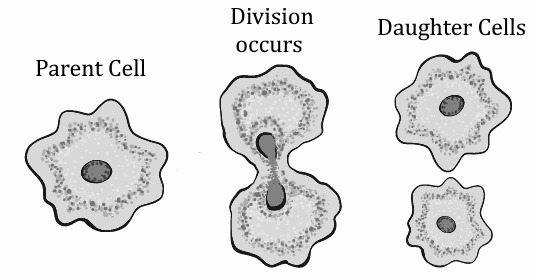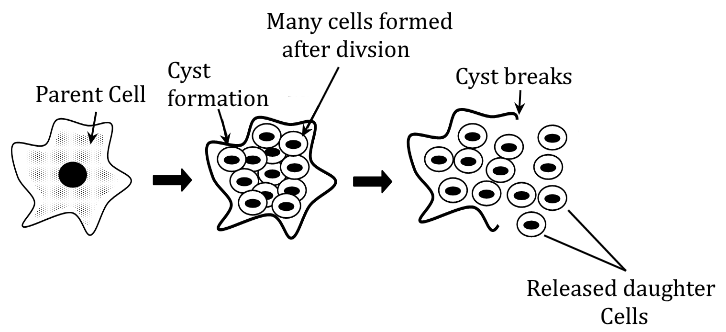
Differentiate between Binary fission and multiple fission.
Answer
443.5k+ views
Hint: The formation of different identical organisms by splitting of the parent organism. Binary fission and multiple fission are both asexual reproduction which occurs only in the presence of one parent.
Complete answer:
Difference between binary fission and multiple fission.
Additional Information:
Asexual reproduction takes place in various ways, one of which is fission. Fission is of two types: binary fission and multiple fission. Binary fission produces two parts that have the potential to grow into new organisms while multiple fission produces many parts that have the potential to grow into many daughter cells. Both methods result in new cells or organisms which are identical to the parents.

Fig.- Binary fission

Fig. - Multiple fission
Note: Living beings produce offspring through two processes- sexual reproduction and asexual reproduction. In sexual reproduction, two parents come together to produce offspring while in asexual reproduction only one parent is involved in producing offspring. Asexual reproduction is of various types including fission, budding, fragmentation, spore formation, and vegetative propagation.
Complete answer:
Difference between binary fission and multiple fission.
| Binary fission | Multiple fission |
| The parent cell divides itself into two equal and identical daughter cells. | The single parent cell is divided into many daughter cells. |
| It is the most common form of reproduction in prokaryotes. | It is the most common type of reproduction in Protists and parasitic species. |
| It occurs during favorable conditions. | It occurs during unfavorable conditions. |
| It has a definite pattern of division. | It does not have a definite pattern of division. |
| It divides only once. | It divides repeatedly. |
| In this, both cytoplasm and nucleus divide together. | In this, the nucleus divides first and is surrounded by cytoplasm whose division occurs later. |
| Example: Bacteria, Amoeba, Euglena, etc. | Example: Plasmodium, Algae, etc. |
Additional Information:
Asexual reproduction takes place in various ways, one of which is fission. Fission is of two types: binary fission and multiple fission. Binary fission produces two parts that have the potential to grow into new organisms while multiple fission produces many parts that have the potential to grow into many daughter cells. Both methods result in new cells or organisms which are identical to the parents.

Fig.- Binary fission

Fig. - Multiple fission
Note: Living beings produce offspring through two processes- sexual reproduction and asexual reproduction. In sexual reproduction, two parents come together to produce offspring while in asexual reproduction only one parent is involved in producing offspring. Asexual reproduction is of various types including fission, budding, fragmentation, spore formation, and vegetative propagation.
Recently Updated Pages
Master Class 11 Economics: Engaging Questions & Answers for Success

Master Class 11 Business Studies: Engaging Questions & Answers for Success

Master Class 11 Accountancy: Engaging Questions & Answers for Success

Master Class 11 English: Engaging Questions & Answers for Success

Master Class 11 Computer Science: Engaging Questions & Answers for Success

Master Class 11 Maths: Engaging Questions & Answers for Success

Trending doubts
Which one is a true fish A Jellyfish B Starfish C Dogfish class 11 biology CBSE

State and prove Bernoullis theorem class 11 physics CBSE

1 ton equals to A 100 kg B 1000 kg C 10 kg D 10000 class 11 physics CBSE

In which part of the body the blood is purified oxygenation class 11 biology CBSE

One Metric ton is equal to kg A 10000 B 1000 C 100 class 11 physics CBSE

Difference Between Prokaryotic Cells and Eukaryotic Cells




